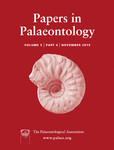Reg. Charity No. 1168330

To further our understanding of the evolution, selectivity and ecological composition of marine communities following the latest Permian mass extinction, new collections from underrepresented regions in the immediate extinction aftermath are required. Here, we provide new systematic data and the first palaeobiological account of the benthic invertebrate community from the Great Bank of Guizhou, South China. We systematically describe three brachiopod species, 26 bivalve species, 11 gastropod species, 1 microconchid and 1 crinoid species. The descriptions include 5 new species; 2 bivalve species (Hoernesia? danisae, Atomodesma? hautmanni) and 3 gastropod species (Donaldina erwini, Cossmannina alfischeri and Vernelia samae). This is the most species‐rich benthic community known so far from the extinction aftermath, which is typically characterized by a high proportion of Permian holdover genera and cosmopolitan taxa. Taxonomically, this community is different from coeval faunas with dissimilarity values >60%. Ecologically, however, this fauna is similar to faunas from the Dolomites (Italy) and East Greenland. This new data, therefore, suggests that the lower Griesbachian invertebrate faunas were taxonomically heterogeneous, whereas ecologically they were relatively homogenous. The marine community on the Great Bank of Guizhou records genera that survived the mass extinction event with some, but not all, recording a size reduction, that is, the Lilliput effect. The absence of large body fossils and the preferential survival of small species suggest that the mass extinction event was size‐selective.